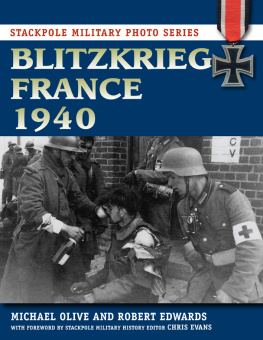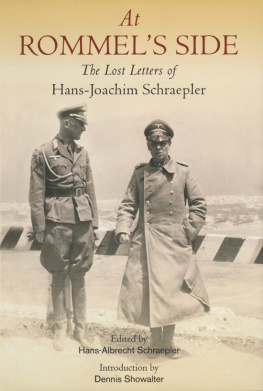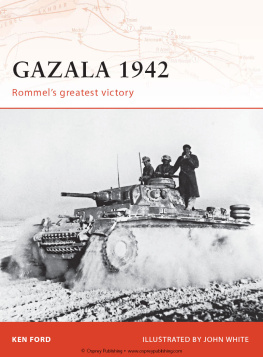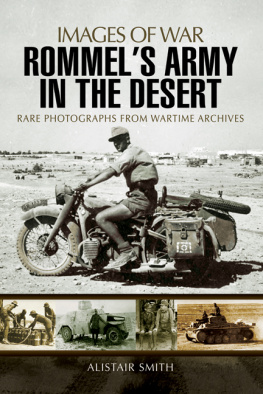Copyright 2012 by Stackpole Books
Published in 2012
by STACKPOLE BOOKS
5067 Ritter Road
Mechanicsburg, PA 17055
www.stackpolebooks.com
All rights reserved, including the right to reproduce this book or portions thereof in any form or by any means, electronic or mechanical, including photocopying, recording, or by any information storage and retrieval system, without permission in writing from the publisher. All inquiries should be addressed to Stackpole Books.
Cover design by Caroline M. Stover
Printed in the United States of America
10 9 8 7 6 5 4 3 2 1
Library of Congress Cataloging-in-Publication Data
Olive, Michael.
Rommels desert warriors : 19411942 / Michael Olive and Robert J. Edwards ; with a foreword by Chris Evans. pages cm. (Stackpole military photo series)
Includes bibliographical references.
ISBN 978-0-8117-1083-1
eISBN 978-0-8117-4584-0
1. Germany. Heer. Panzerarmeekorps Afrika. 2. Germany. Heer. Panzerarmeekorps AfrikaPictorial works. 3. World War, 19391945CampaignsAfrica, North. 4. World War, 19391945CampaignsAfrica, NorthPictorial works. 5. Rommel, Erwin, 18911944. 6. Rommel, Erwin, 18911944Pictorial works. 7. World War, 19391945Regimental historiesGermany. I. Edwards, Robert J. II. Title.
D757.55.A4O45 2012
940.54'13430961dc23
2012024592
CONTENTS
FOREWORD
T here exists a real danger that our friend Rommel is becoming a kind of magical or bogey-man to our troops. Indeed, German General Erwin Rommel earned his Desert Fox nickname by employing bold, risky tactics that saw him best much larger enemy formations while avoiding what often appeared to be certain defeat time and again. Rommel, however, was far from perfect. While his unpredictability proved a tricky thorn to the British, Rommels own forces often didnt know where the wily Desert Fox was or what he was up to. This produced worrying confusion among his own headquarters staff, distrust among his Italian allies, and complaints from his superiors, who thought he was in over his head. Still, Claude Auchinleck, the British general in command of the 8th Army in North Africaand for a time Rommels counterpart in the see-saw battle that raged across the desertwas having a difficult time convincing his troops that Rommel and his vaunted Afrika Korps were merely men and, more importantly, men who could be beaten.
The Deutsches Afrika Korps (DAK) began humbly enough, arriving piecemeal in Africa beginning in February 1941 to act as a small supporting force for the beleaguered Italian Army that was on the verge of being run out of Africa by the British. No one, least of all Adolf Hitler, expected the newly formed DAK to do much more than stabilize the situation. In fact, Rommels orders were not to attack, but to wait until more forces arrived. Rommel didnt listen, and an Italian rout became a British one, with the Desert Fox nipping at their heels.
In Rommels Desert Warriors, the stark beauty of the North African desert is revealed in original photographs taken by the German soldiers who fought there. Its worth remembering as you look through the book that the war in the desert was fought across the vast Sahara (an Arabic word which simply means desert) in temperatures that ranged in excess of 110 degrees Fahrenheit to below freezing conditions at night. Sandstorms, known locally as simoompoison windscoured the desert floor, creating blinding clouds of skin-abrading sand. Water was scarce and navigation exceptionally difficult in a landscape that changed rapidly. It was a hellish place to fight a war, yet the North African campaign became one known for its chivalry.
New photographs of Rommel himself give additional insight into the warrior who so perplexed his allies and enemies. From panzers churning across the sand to fortified positions made of rock, the photographs capture what it was like to live and fight in one of the harshest climates on the planet. In order to survive, let alone prevail, the German Army issued specialized uniforms and weapons for the desert environment. Once again, we include an eight-page color spread depicting original items from the North African campaign. And throughout the book, German military history experts Robert Edwards and Michael Olive add context and detail to the hundreds of photos presented here.
Rommel and the Afrika Korps hold a hallowed place in military history. They fought in an unforgiving environment against overwhelming odds, and though their ultimate fate would be defeat, they nonetheless wrote their names into the history books as one of the most daring fighting forces to ever go to war. Here, in Rommels Desert Warriors, youll see why.
Chris Evans
Editor
Stackpole Books
INTRODUCTION
O n 8 February 1942, British units of the Western Desert Force, under the command of General Sir Richard OConnor, were on the frontier between Cyrenaica and Tripolitania. The strategic port of Tripoli was under threat, and there was the possibilty that the Italians could be ejected from North Africa.
The attempted Italian invasion of Egypt by Marshal Rodolpho Grazianis 10th Army had ended in disaster. Forty thousand Commonwealth troops had taken over 130,00 Italian prisioners and occupied Cyrenaica.
In order to assist their Axis partner, the Germans decided to step in. The mission was to to be strictly defensive in nature.
According to War Directive No. 22, German support for battles in the Mediterranean area was required:
The situation in the Mediterranean area, where England is employing superior forces against our allies, requires that Germany should assist for reasons of strategy, politics, and psychology. Tripolitania must be held and the danger of a collapse on the Albanian front must be eliminated.
I therefore order as follows:
Commander in Chief Army will provide covering forces sufficient to render valuable service to our allies in the defense of Tripolitania, particualrly against British armored divisions. Special orders for the composition of this force will follow.
The North African operation was given the code name Sonnenblume (Sunflower). Relatively modest German forces were proposed, consisting of two Panzer divisions: the 5. leichte Division consisting of cadres from the 3. Panzer- Division plus its Panzer-Regiment 5; and the 15. Panzer-Division.
Command of these formations was entrusted to Generalleutant Erwin Rommel. Rommel had won fame in France as commander of the 7. Panzer-Division. His division had moved so rapidly and maneuvered so skillfully that it was nicknamed the Ghost Division. The German forces in Africa were to receive the title Deutsches Afrikakorps (DAK), and a legend was born.
From the time that Rommel arrived in Tripoli, on 12 February 1941, the war in Africa changed dramatically. Without waiting for the bulk of his forces to arrive, Rommel decided to go on the offensive.
The 194142 North African campaign was fought along a fairly narrow coastal strip of some 1,200 miles (1,900 kilometers) from El Agheila to El Alamein. Both the Axis and Allied forces involved were, at least at the begining of the campaign, relatively small in number.
The fighting was hard but generally conducted in a fair manner. Prisioners were well treated, and enemy wounded received ap propriate medical treatment. There was a mutual respect between the German and Commonwealth forces that extended from the common soldier to general officers. Both sides shared the hardships and privations of the desert environment. There was little of the animosity that characterized the later campaigns in Italy and Europe.













